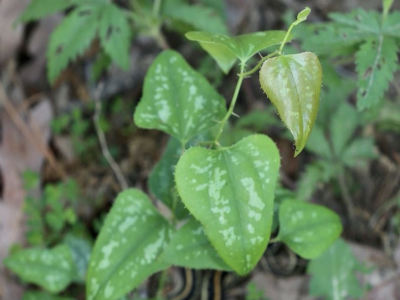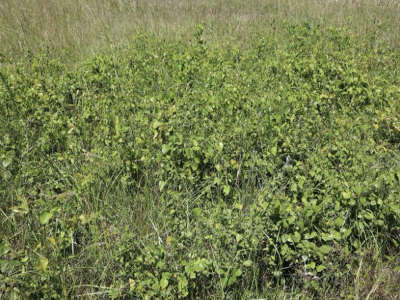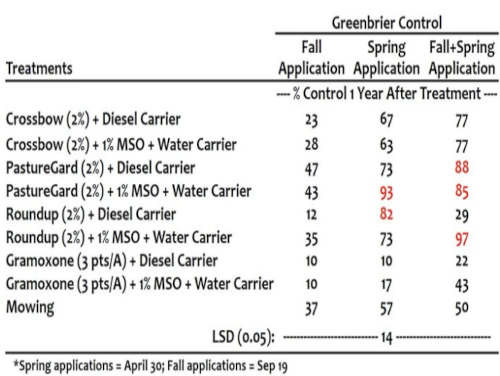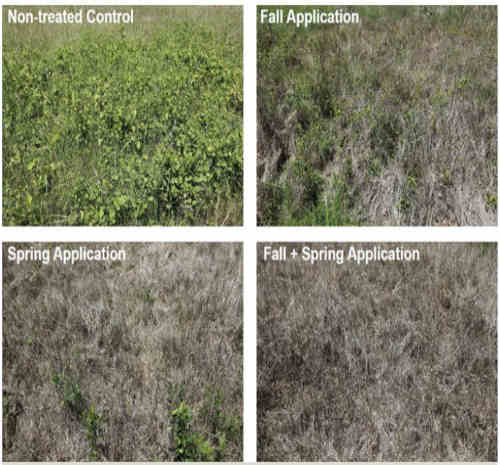Greenbrier species (Smilax species) can be found throughout Southern Missouri and much of the south-central regions of the United States. Greenbrier is a perennial vining plant with waxy, alternately arranged heart shaped leaves. The stems and vines of greenbriers may become woody and have spines or prickles. One of the most common greenbriers we encounter in Missouri is known by a variety of different names including Sawbriar, Catbriar, or just simply greenbrier (Figure 1). Greenbriers are well adapted to various soil types, have moderate drought tolerance and low fertility requirements, and prefer to grow in undisturbed areas. If left unchecked, greenbrier can form dense mats, out-competing other desired plant species (Figure 2). All of these factors make greenbrier a prime candidate for being a difficult weed of pastures, fencerows, and other similar areas, particularly in the southern Ozarks region of Missouri.

Figure 1 Greenbrier is a perennial vining plant with heart-shaped leaves and stems that have spines or prickles.

Figure 2 If left undisturbed, greenbrier can climb over and crowd out all other vegetation present.
Over the years, we have received numerous questions about the control of these species. We were notified of a dense stand of greenbrier in an abandoned tall fescue field in Taney County Missouri in 2019 and so we initiated a research trial to determine the best method(s) for the control of this troublesome species. Herbicide applications were made in either the fall of 2019 or spring of 2020, or sequentially in both the fall and spring. Based on previous research and recommendations, we evaluated Crossbow (2,4-D + triclopyr), PastureGuard HL (triclopyr + fluroxypyr), and Roundup Powermax (glyphosate) at a rate of 2% by volume (v/v). Although it may not be the best fit for a pasture environment, we also evaluated Gramoxone (paraquat) at a rate of 3 pints per acre, in part because we have seen some instances where this herbicide is able to control certain perennial weeds with sequential applications. Another component of the treatment structure was that all of the herbicides were applied with either a water or a diesel fuel carrier. Lastly, we included mowing as a management practice for comparison to all of these herbicide treatments. Visual greenbrier control was then evaluated the season following treatment.
The results from this experiment are presented in Tables 1 and 2. Overall, fall did not prove to be an effective treatment time for the control of greenbrier, as all herbicide treatments applied in the fall provided less than 50% control of this species. When these same herbicide treatments were applied in the spring, PastureGard HL applied with water as a carrier provided 93% control, while a 2% Roundup solution in a diesel fuel carrier provided 82% control. Statistically, these two treatments provided similar and highest levels of control when applied in the spring. Obviously the benefit of PastureGard HL in comparison to the Roundup treatment in this setting is that PastureGard HL is safe for use on grasses and does not injure tall fescue whereas Roundup is a nonselective herbicide and will kill any desirable forage grasses that it contacts (Table 2).

Table 1 Greenbrier control following herbicide or mowing treatments made in a Missouri pasture (Taney County, Missouri 2019-2020)

Table 2 Tall fescue injury following herbicide or mowing treatments to control greenbrier in a Missouri pasture.
Sequential applications of certain of these treatments in the fall and spring resulted in some of the highest overall levels of greenbrier control that we observed, although it should be noted that statistically, the single application of PastureGard HL in the spring with water as a carrier was as good as any of the sequential treatments evaluated. PastureGard HL applied sequentially in either the water or diesel fuel carrier provided 85 to 88% control of greenbrier, while sequential applications of Roundup applied in water as a carrier provided 97% control. We are not sure why sequential applications of Roundup in the diesel fuel carrier provided such poor control of greenbrier, but it was a consistent response observed throughout all the plots. It may be that the fall application of Roundup in this diesel fuel carrier burns the foliage and stems too much and therefore prevents adequate translocation of the herbicide. Then, by the time of the spring application, there was still not enough regrowth to cover the plants compared to greenbrier that had not been treated yet. Lastly, Gramoxone was the least effective of any of the herbicide treatments evaluated, regardless of the application timing.
Another key finding from this experiment was that the diesel fuel carrier did not increase control of this species compared to using water as a carrier and including an effective surfactant. In fact, in many cases, the diesel fuel carrier decreased the greenbrier control compared to the same herbicide treatment applied in water. The diesel fuel carrier often caused greater tall fescue injury as well (Table 2).
Just mowing the greenbrier without any herbicide treatment provided 37 to 57% control of greenbrier, which was somewhat surprising (to us). This suggests that sequential mowings within a season and for several seasons in a row may likely provide even higher levels of control of this species. The response of greenbrier to mowing is consistent with our observation that greenbrier is most commonly found in undisturbed locations and is usually not encountered in locations that are mowed with any regularity.

Figure 3 Influence of PastureGard HL applied at 2% v/v in a water carrier on greenbrier control and tall fescue injury at different application timings.
Overall, results from this experiment indicate that PastureGard HL® in a water carrier applied in the spring (when the plants have just leafed out) is an excellent treatment for the control of greenbrier and does not harm tall fescue (Figure 3). Roundup in a water carrier applied sequentially in the fall and spring also resulted in excellent control of greenbrier but should be used as a spot treatment only as this treatment will kill any desirable forage grass that it contacts (Figure 4). Finally, mowing for just one season can reduce the greenbrier population by about half, but it is unclear if mowing alone will ever be able to completely eliminate this tough perennial weed that has such large rootstocks.

Figure 4 Influence of Roundup Powermax applied at 2% v/v in a water carrier on greenbrier control and tall fescue injury at different application timings.
Source : missouri.edu